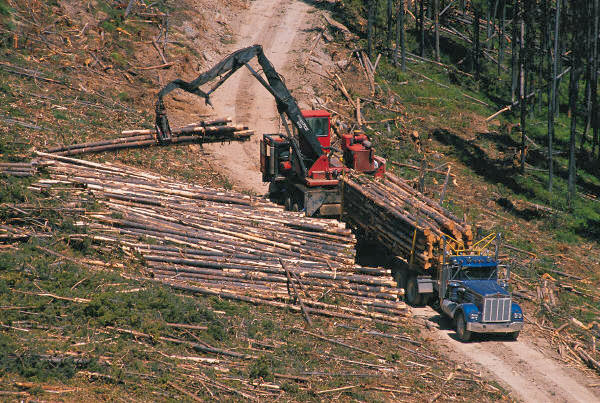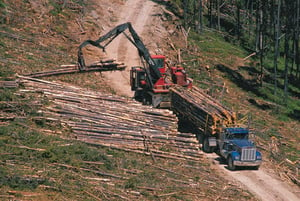3 min read
5 Steps for Siting a Wood-based Manufacturing Facility
 Suz-Anne Kinney
:
December 11, 2015
Suz-Anne Kinney
:
December 11, 2015

Any manufacturing facility that uses wood as a raw material—sawmills, pulp & paper mills, panel mills, pellet mills, as well as biofuels and biochemicals producers—relies in large part on the availability of affordable and sustainable feedstock for its long-term success. Prior to siting a new facility, or even deciding whether to purchase a closed or operating facility, due diligence requires that the project developer seek verification that adequate feedstock can be procured from the supply region for the life of a project. This verification is a complicated process, however. For project developers, there are five steps that, if followed, will determine whether a particular location will support the project and improve the chances of project success.
1) Quantify current forest inventory, annual forest growth, and annual consumption in the supply area
To quantify current forest inventory, knowing the total number of tons, MBF or cubic meters of growing stock that resides in the forest is not enough. Why? Total forest inventory is not always synonymous with the supply available to commercial operations. As a result, it is necessary to distinguish between current forest inventory and the inventory available to consumers of wood raw materials. Geographical (steep terrain, weather, etc.) and economic challenges can both preclude the timber in a specific area from being harvested. By looking at this total over the most recent five-year period, annual growth rates can also be ascertained.
Once the volume of commercially-available timber and the annual growth rate are calculated, the next stage is to establish current harvest volumes by following this process:
- Identify all competitive facilities that consume wood raw materials in the supply area.
- Determine how much wood each facility consumes annually. Using actual consumption numbers—not production capacity numbers—is important, as mills tend to run at less than full capacity.
By adding the total current consumption and the expected consumption of the new facility, and subtracting this number from the annual growth number will provide a snapshot of whether sufficient supply to sustain operations currently exists.
2) Grow the forest forward to forecast future inventory and harvest volumes
In both forests and forest products markets, however, things change. As a result, a forecast of both supply and demand provides insight into long-term sustainability.
An accurate picture of future demand is best established by considering different scenarios unique to a single project and its supply shed. In each demand scenario, it is critical to identify growth-to-drain ratios as a measure of sustainability. A positive ratio of 1.0 or greater must be maintained in order to ensure sustainable wood supply.
When harvest removals exceed forest growth, supply will become constrained and prices will reach a level where some consumers might be forced to exit the market. Known in advance, however, the risks inherent in the brief windows where growth-to-drain ratios dip below 1.0 can be managed.
3) Determine whether loggers in the area have adopted the technology needed to harvest and deliver wood fuel
Most wood consuming facilities use wood fuel either to dry other wood products or to generate their own electricity. One of the best sources of this fuel is harvest residues. Because the it is expensive to recover wood residues, when only a small market exists for this material, loggers are less likely to invest in the equipment, staff and time it takes to gather this low-value material. Knowing how many loggers in the supply area currently harvest and deliver wood fuel is key, as is having a plan to incentivize additional loggers to undertake this activity.
4) Understand current and future timber prices in the supply area
The cost of wood depends on demand and the amount of timber available to meet that demand. For  example, stumpage prices spike when new demand enters the market and puts pressure on current forest resources. Like forecasting future harvest volumes, full-spectrum demand scenarios are necessary to adequately forecast feedstock costs at start-up and into the future.
example, stumpage prices spike when new demand enters the market and puts pressure on current forest resources. Like forecasting future harvest volumes, full-spectrum demand scenarios are necessary to adequately forecast feedstock costs at start-up and into the future.
5) Identify optimal logistics for wood delivery to the facility
Details pertaining to logistics are easy to overlook, but they can ultimately have a major impact on successful facility operations. For instance, is a facility’s woodyard sufficient to receive the number of daily truckloads required to maintain a desired output? Keep in mind, seasonal factors like wet weather can result in weeks or months of no logging and, subsequently, no deliveries.
Another logistics question involves the number of miles between a facility and major roadways, rail lines and ports. Will the transport costs of moving a finished product to its final destination be reasonable enough to guarantee a profit? The answer to such a question can significantly influence where project developers locate their plants.
Keeping these factors in mind requires a deep understanding of the wood fiber supply chain. As the housing market recovers, the pulp and paper industry flourishes in Africa, Asia Pacific, Latin American and the Middle East (newsprint is the only pulp and paper end product with decreasing global demand) and bioenergy, biofuels and biochemicals markets mature, competition for wood fiber will intensify in local supply areas. The onus will be on project developers to achieve a comprehensive knowledge of supply chain and other operational issues that affect project bankability and, ultimately, project success.





